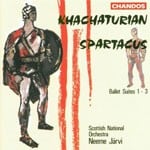Spartacus
(Spartakus) - Suite No. 3 from the ballet (1950-54, rev.1960/68)3(III=picc).2.corA.2(II=Ebcl).bcl.2-4.3.3.1-timp.perc:tgl/wdbl/tamb/SD/BD/cyms/tubaphone/glsp/xyl-hp-pft-str
Abbreviations (PDF)
VAAP
1.In the Market Place 2.Dance of the Ethiopian Boy (Dance of the Grecian Slave) 3.Dance of the Egyptian Maidens 4.Phrygia’s Prophecy and Farewell to Spartacus / Parting of Spartacus and Phrygia 5.Sword Dance
Ever since being used as the theme tune to BBC TV’s The Onedin Line, the Adagio from Spartacus – originally danced by the hero and his wife Phrygia – has been an international hit and the single best-known number of the ballet. But how many people know the original full ballet score, scored for a large orchestra and chorus? And how much more powerful that Adagio is when heard in context!
For, unlike Gayaneh, Spartacus is not merely a ballet of dance ‘numbers’, but Khachaturian’s most ambitious stage work, in which he emulated the symphonic style of the best ballets of Tchaikovsky and Prokofieff (particularly of Romeo and Juliet). That said, the entire score is probably best heard accompanying the ballet itself. In concert, highlights from the ballet are often programmed, including four orchestral suites selected by the composers and scenes taking the form of symphonic pictures.
Suite No.3 opens with three ‘character’ dances taken from the ballet’s opening act, set in the slave market. Dance of the Ethiopian Boy in particular is lively, rich with percussion and baying horns, and is well-contrasted with the languorous Dance of the Egyptian Maidens. The suite also includes the well-loved theme from the Adagio, in the guise of Parting of Spartacus and Phrygia where it appears in its tenderest form with tremolando violas and pizzicato bass accompaniment. The suite ends with the swaggering Sword Dance, a perky trumpet fanfare based on a satirical treatment of the love theme.
Note by Daniel Jaffé

Royal Scottish National Orchestra/Neeme Järvi
Chandos CHAN 8927
